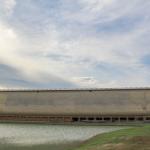“How Could Noah’s Ark Survive the Storm?” asks Answers in Genesis’ Tim Chaffey in a recent article. “Skeptics claim that a wooden ship the size of Noah’s Ark couldn’t possibly stay afloat,” Chaffey notes. “Did God perform a miracle to keep it from sinking?”
Take a moment to notice the question Chaffey is asking: Could Noah’s ark as described in Genesis have successfully remained afloat, or did it take a miracle? Now consider the question Chaffey is not asking: Could Noah’s ark as described in Genesis have successfully remained afloat, or is the story impossible?
One problem with young earth creationism is that it is literally unfalsifiable. Young earth creationists often claim that evolution is not real science because it is not falsifiable. (This is not true, and evolutionary scientists are constantly revising specific points of evolution in response to new evidence.) And yet, note what’s happening here: a miracle is being floated as a solution if the dimensions of the ark are incompatible with being seaworthy.
Chaffey is not asking whether the possibly inoperable design of the ark as laid out in Genesis may make the flood story, as laid out in Genesis, unworkable. Chaffee does not even consider that as a possibility. If the dimensions of Noah’s Ark are proved incompatible with being seaworthy, then clearly God performed a miracle.
Do you know what’s literally unfalsifiable? A 4,500-year-old miracle.
Chaffey does not actually believe it took a miracle. He spends his article arguing that the ark could indeed have floated, and discusses various mechanisms Noah might have used to keep it pointed into the waves. He then concludes as follows:
The Bible explains that only eight people survived the Flood in Noah’s Ark (1 Peter 3:20). So, yes, the Ark floated and kept its human and animal passengers safe from the most devastating catastrophe this world has ever known.
Just so we’re clear, this is not how science works. You don’t start with your conclusions, and you certainly don’t base your science on statements made in a 2000-year-old religious text. Chaffey concludes that regardless of whether the dimensions of the ark stated in Genesis make sense, the ark floated, because the Bible says it floated.
This, again, is not how science works.
Chaffey concludes as follows:
We need not appeal to God’s miraculous power to explain how it survived the Flood. Instead, we can trust that God chose the man he had prepared to carry out this vital task and that righteous Noah was capable of obeying God’s instructions wisely.
Chaffey’s argument seems to be that the ark would have been seaworthy because the Bible says God gave Noah guidelines for building the ark and that the ark floated, and besides, God would not have commanded Noah to build a boat that was not seaworthy. We don’t need to appeal to God’s miraculous power to explain how Noah’s Ark survived the flood, Chaffey concludes. Still, the message comes across loud and clear—if we needed to, we could.
This is what it looks like for something to be unfalsifiable, and this is why “creation science” is not science. Young earth creationists try very hard to talk like they’re scientists, but when the going gets tough, they have no problem appealing to miracles. That’s not how science works. Young earth creationists are not scientists.
I have a Patreon! Please support my writing!















